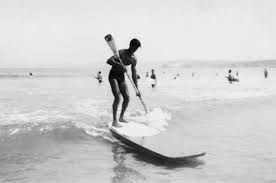Stand Up Paddleboarding history
We love history here at The SUP Store - Christchurch, Dorset - we was established in 2009 so pretty much the beginning on paddleboarding in the UK.
Stand-up paddleboarding (SUP) has a relatively recent history compared to other water sports, but it has gained significant popularity in a short period of time. Here's a brief overview of the history of stand-up paddleboarding:

-
Origins in Ancient Cultures: While stand-up paddleboarding as we know it today emerged in the modern era, the concept of standing on a board and propelling oneself with a paddle can be traced back to ancient cultures. Indigenous people in Africa, Peru, and Polynesia used similar techniques for transportation, fishing, and even warfare.
-
Modern Revival in Hawaii: The modern resurgence of stand-up paddleboarding is often credited to the Hawaiian Islands. In the 1940s and 1950s, beach boys in Waikiki, such as Duke Kahanamoku, began using paddleboards to get a better view of the surf and incoming swells. They used longboards and canoe paddles to propel themselves, combining elements of surfing and canoeing.
-
Surfing Influences: Stand-up paddleboarding's roots are deeply connected to surfing. Surf instructors in Hawaii started using SUP boards as a way to manage groups of learners more effectively, providing them with stability and visibility. The popularity of stand-up paddleboarding as a recreational activity grew within the surfing community.
-
Modern Development: Stand-up paddleboarding as a distinct sport started to take shape in the early 2000s. Surfers such as Laird Hamilton and Dave Kalama began experimenting with SUP as a way to train and catch smaller waves on flat days. They helped refine the equipment, developing specialized paddleboards with increased buoyancy and stability.
-
Global Expansion: Stand-up paddleboarding gained mainstream attention in the mid-2000s, primarily in coastal regions. It quickly spread to various parts of the world, attracting water enthusiasts of all ages and fitness levels. Paddleboarding races, competitions, and tours began to emerge, further solidifying its place as a popular water sport.
-
Diverse Applications: Stand-up paddleboarding's versatility contributed to its widespread adoption. It can be enjoyed in a variety of settings, including lakes, rivers, and even open ocean. People use paddleboards for leisurely paddles, fitness and yoga workouts, fishing, and exploring remote waterways.
-
Equipment Evolution: As stand-up paddleboarding gained momentum, the equipment evolved. Manufacturers started producing a range of SUP boards, including inflatable and rigid options, catering to different skill levels and activities. Paddles also became lighter and more ergonomic, enhancing the overall experience.
-
Competitive Scene: Stand-up paddleboarding competitions have grown in popularity, with events ranging from recreational races to professional tournaments. The sport has various disciplines, such as SUP surfing, flatwater racing, downwind racing, and whitewater paddling. The International Surfing Association (ISA) and the Association of Paddlesurf Professionals (APP) organize major SUP events worldwide.
Today, stand-up paddleboarding continues to thrive as a recreational and competitive sport, enjoyed by millions of people around the globe. It offers a unique way to connect with nature, explore waterways, and engage in a full-body workout while enjoying the serenity of being on the water.

